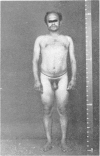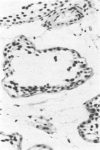Abstract
This paper reports a rearrangement involving three autosomes: 11, 12, and 21. The translocation carrier, a 31-year-old azoospermic male, is phenotypically normal.
Full text
PDF


Images in this article
Selected References
These references are in PubMed. This may not be the complete list of references from this article.
- ARAKAKI D. T., SPARKES R. S. MICROTECHNIQUE FOR CULTURING LEUKOCYTES FROM WHOLE BLOOD. Cytogenetics. 1963;2:57–60. doi: 10.1159/000129767. [DOI] [PubMed] [Google Scholar]
- Allderdice P. W., Miller O. J., Miller D. A., Breg W. R., Gendel E., Zelson C. Familial translocation involving chromosomes 6, 14 and 20, identified by quinacrine fluorescence. Humangenetik. 1971;13(3):205–209. doi: 10.1007/BF00326943. [DOI] [PubMed] [Google Scholar]
- Ballesta F., Fernández E., Milá M. Translocation t (1;8;15) maternelle et trisomie 8qter chez la fille. Conseil génétique. J Genet Hum. 1980 Sep;28(3):361–366. [PubMed] [Google Scholar]
- Bloom S. E., Goodpasture C. An improved technique for selective silver staining of nucleolar organizer regions in human chromosomes. Hum Genet. 1976 Oct 28;34(2):199–206. doi: 10.1007/BF00278889. [DOI] [PubMed] [Google Scholar]
- Buchanan P. D., Rao K. W., Doerr C. L., Aylsworth A. S. A complex translocation involving chromosomes 3,11, and 14 with an interstitial deletion, del(14) (q13q22) in a child with congenital glaucoma and cleft lip and palate. Birth Defects Orig Artic Ser. 1978;14(6C):317–322. [PubMed] [Google Scholar]
- Cacheiro N. L., Russell L. B., Swartout M. S. Translocations, the predominant cause of total sterility in sons of mice treated with mutagens. Genetics. 1974 Jan;76(1):73–91. doi: 10.1093/genetics/76.1.73. [DOI] [PMC free article] [PubMed] [Google Scholar]
- Creasy M. R., Crolla J. A., Daker M. G. A familial reciprocal translocation between three chromosomes. Humangenetik. 1974;24(4):303–308. doi: 10.1007/BF00297594. [DOI] [PubMed] [Google Scholar]
- Dallapiccola B., Bollea G., Mazzilli C., Gandini E. Complex translocation t(9;21)(9;22)(q12p13)(q12q11) in the family of a child with 9p trisomy syndrome. Hum Genet. 1976 Jul 7;33(1):73–76. doi: 10.1007/BF00447289. [DOI] [PubMed] [Google Scholar]
- Fredga K., Hall B. A complex familial translocation involving chromosomes 5, 9 and 13. Cytogenetics. 1970;9(4):294–306. doi: 10.1159/000130099. [DOI] [PubMed] [Google Scholar]
- Hustinx T. W., Nabben F. A., Scheres J. M. Partial trisomy of chromosome 1 resulting from a complex maternal rearrangement of chromosomes 1, 5, and 6. Am J Med Genet. 1979;3(4):353–358. doi: 10.1002/ajmg.1320030406. [DOI] [PubMed] [Google Scholar]
- Lyon M. F., Meredith R. Autosomal translocations causing male sterility and viable aneuploidy in the mouse. Cytogenetics. 1966;5(5):335–354. doi: 10.1159/000129909. [DOI] [PubMed] [Google Scholar]
- Muneer R. S., Donaldson D. L., Rennert O. M. Complex balanced translocation of chromosomes 2, 3, and 13. Hum Genet. 1981;59(2):182–184. doi: 10.1007/BF00293074. [DOI] [PubMed] [Google Scholar]
- Nuzzo F., Marini A., Baglioni C., Ford C. E., De Carli L., Piceni Sereni L. A case of multople chromosomal rearrangements with persistence of foetal haemoglobin. Cytogenetics. 1968;7(3):169–182. doi: 10.1159/000129981. [DOI] [PubMed] [Google Scholar]
- Palmer C. G., Poland C., Reed T., Kojetin J. Partial trisomy 11,46,XX,-3,-20, + der3, + der20,t(3:11:20), resulting from a complex maternal rearrangement of chromosomes 3, 11, 20. Hum Genet. 1976 Feb 29;31(2):219–225. doi: 10.1007/BF00296149. [DOI] [PubMed] [Google Scholar]
- Scheres J. M. Production of C and T bands in human chromosomes after heat treatment at high pH and staining with "stains-all". Humangenetik. 1974;23(4):311–314. doi: 10.1007/BF00272515. [DOI] [PubMed] [Google Scholar]
- Schwinger E., Mikkelsen M., Niesen M. Familial balanced (7;11;21) translocation and Down's syndrome in two siblings. Clin Genet. 1975 Apr;7(4):304–307. doi: 10.1111/j.1399-0004.1975.tb00333.x. [DOI] [PubMed] [Google Scholar]
- Seabright M. A rapid banding technique for human chromosomes. Lancet. 1971 Oct 30;2(7731):971–972. doi: 10.1016/s0140-6736(71)90287-x. [DOI] [PubMed] [Google Scholar]
- Searle A. G. Nature and consequences of induced chromosome damage in mammals. Genetics. 1974 Sep;78(1):173–186. doi: 10.1093/genetics/78.1.173. [DOI] [PMC free article] [PubMed] [Google Scholar]
- Tabor A., Jensen L. K., Lundsteen C., Niebuhr E. A 5;7, 5;12 double reciprocal translocation in a normal mother and a 5;7 translocation with a recombinant chromosome 5 in her normal child. J Med Genet. 1981 Aug;18(4):307–309. doi: 10.1136/jmg.18.4.307. [DOI] [PMC free article] [PubMed] [Google Scholar]
- Taillemite J. L., Baheux-Morlier G., Cathelineau L., Roux C. Maladie du cri du chat associée à un remaniement chromosomiqe complexe chez un jumeau dizygote. Ann Genet. 1973 Jun;16(2):127–130. [PubMed] [Google Scholar]
- Tanaka N., Ikeuchi T., Yara I., Kitahara K. Trisomy 9p due to a maternal complex translocation involving chromosomes 4, 6 and 9. Jinrui Idengaku Zasshi. 1977 Mar;21(4):261–268. [PubMed] [Google Scholar]






